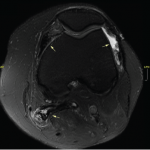When I first met Betty, now wheelchair bound, she could barely recount her history. “I am just too tired to talk, doctor. Can I come back another day?”
Something was amiss; her extreme somnolence and lethargy, her deepening voice could not be linked to lupus. The mystery was solved when her circulating serum thyroxine level was barely detectable and her serum thyroid-stimulating hormone level returned in the stratospheric range, 250 units (normal up to 5 units): a classic example of a functioning endocrine feedback loop. Betty was, literally, hours away from descending into myxedema coma.
Many months later, following Betty’s recovery, it became evident that her prior diagnosis of lupus was in error. Her weakness, lethargy, full facies, thinning hair, general malaise and positive ANA masqueraded as lupus when, in fact, these findings could all be attributed to another autoimmune disorder: hypothyroidism caused by Hashimoto’s disease that had annihilated her thyroid gland years earlier. Although she had taken thyroxine for years, it was mistakenly discontinued when she changed primary care doctors. She was advised that it was no longer required—a near fatal error.
The thyroid–muscle interaction can be double edged. A sluggish or an overactive thyroid gland can profoundly influence muscle strength. The latter holds true for thyrotoxic periodic paralysis, a disorder observed in about 15% of Asian men with hyperthyroidism characterized by the abrupt onset of hypokalemia and paralysis primarily affecting the legs.4 Patients are literally stopped in their tracks until the episode of profound weakness resolves.
My brush with this illness occurred years ago when, as a medical resident, I examined a Korean postdoctoral mathematics student who was referred to neurology clinic for his episodic weakness. Living on a tight budget, he described a weekly ritual of consuming as many as six bowls of pasta every Tuesday night at a neighborhood all-you-can-eat restaurant, and he noticed that he would be unable to rise out of bed every Wednesday morning. He adapted to the situation by lying in bed for about an hour, patiently solving quadratic equations, waiting for his legs to recover so that he could start moving again.
The high-carbohydrate load of bowls of pasta can trigger a surfeit of insulin secretion that in turn stimulates excess Na+/K+ ATPase activity in muscle cells, causing a dramatic drop in potassium that renders the muscles dysfunctional.4 Next time, may I suggest a bowl of kimchi?
Muscle & Bone
Our skeletons influence our strength. It has long been observed that osteomalacia due to severe vitamin D deficiency can be associated with weakness. Similarly, patients with cancer that has metastasized to bone are often weaker than one would expect based on the skeletal location of their lesions. Why?


